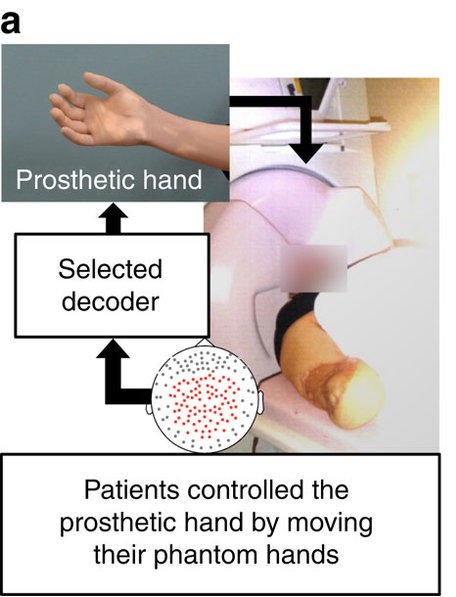脳の感覚運動野における可塑性の誘導が幻肢患者の疼痛をコントロールする
Induced sensorimotor brain plasticity controls pain in phantom limb patients
2016年10月27日 Nature Communications 7 : 13209 doi: 10.1038/ncomms13209

求心路の部分的あるいは完全な遮断後に生じる幻肢痛の原因は重要な問題である。幻肢痛が、感覚運動野における不適応な機能再構築の結果生じるという説が広く知られているが、最近異論が高まりつつある。この説に従えば、失った機能を再建する形で、実験的に新たな機能再構築を誘導すれば、疼痛が減弱すると期待される。今回我々は、脳磁計信号を実時間で用いるブレイン・マシン・インターフェイス(BMI)を使って、障害されている手の動きをロボット義手で再建した。このBMIを使った訓練によって、義手の制御が改善され、脳磁計信号による運動情報の識別能が向上し、感覚運動野に顕著な可塑的変化が誘導されたことが示された。しかし、機能回復は疼痛を減弱させるだろうという我々の当初の予想に反して、このBMI操作訓練により疼痛は強くなった。一方、義手の動きと幻肢に対応する脳活動とを切り離すように設計されたBMI訓練では、疼痛が減弱した。これらの結果は、感覚運動野の可塑性と疼痛の間の機能的関連を明らかにしており、BMIフィードバックによる新しい治療法の可能性を示した。
Corresponding Author
The cause of pain in a phantom limb after partial or complete deafferentation is an important problem. A popular but increasingly controversial theory is that it results from maladaptive reorganization of the sensorimotor cortex, suggesting that experimental induction of further reorganization should affect the pain, especially if it results in functional restoration. Here we use a brain–machine interface (BMI) based on real-time magnetoencephalography signals to reconstruct affected hand movements with a robotic hand. BMI training induces significant plasticity in the sensorimotor cortex, manifested as improved discriminability of movement information and enhanced prosthetic control. Contrary to our expectation that functional restoration would reduce pain, the BMI training with the phantom hand intensifies the pain. In contrast, BMI training designed to dissociate the prosthetic and phantom hands actually reduces pain. These results reveal a functional relevance between sensorimotor cortical plasticity and pain, and may provide a novel treatment with BMI neurofeedback.

